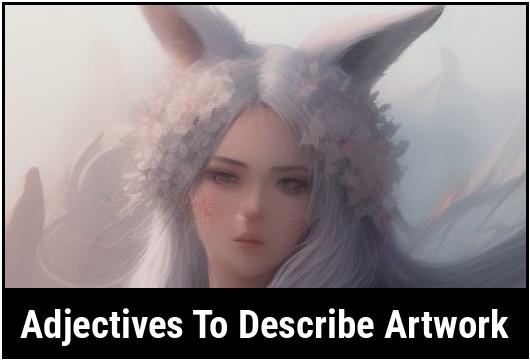- You are here:
- Home »
- adjectives
- » 31 Adjectives To Describe Artwork

31 Adjectives To Describe Artwork
Art encompasses a wide range of mediums, styles, and emotions, making it a diverse and subjective form of expression. When it comes to describing artwork, adjectives play a crucial role in capturing the complexity, beauty, and impact of a piece. Selecting the right adjectives not only allows for a more precise understanding and communication of the artwork but also enables individuals to appreciate and evaluate it more deeply.
Key Takeaways
- Adjectives serve as a means to convey the visual, emotional, and conceptual qualities of artwork.
- Choosing the appropriate adjectives enhances the understanding and expression of the art piece’s significance and impact.
- Adjectives create a vivid and rich description that evokes a more profound connection and appreciation of the artwork.
Adjectives To Describe Artwork
1. Vibrant
Vibrant is an adjective that describes artwork that is filled with intense and lively colors or tones, creating a sense of energy and vitality. Such artwork often captivates the viewer’s attention and leaves a lasting impression.
2. Serene
Serene artwork evokes a peaceful and tranquil ambiance, often characterized by soft and gentle colors. It can transport the viewer to a place of calmness, providing a momentary escape from the chaos of everyday life.
3. Bold
Bold artwork exhibits a fearless and confident approach, often featuring strong and striking colors, shapes, or forms. It grabs attention and makes a statement, leaving an indelible mark on the viewer’s mind.
4. Intricate
Artwork described as intricate showcases a meticulous attention to detail, often incorporating intricate patterns, textures, or designs. When admired closely, the viewer can appreciate the artist’s skill and precision in creating such elaborate work.
5. Ethereal
Ethereal artwork possesses an otherworldly beauty, leaving viewers with a sense of wonder. It often incorporates translucent, light or delicate elements that give the impression of something celestial or supernatural.
6. Dynamic
Dynamic artwork captures movement and energy, creating a sense of motion or action within the piece. Whether through brushstrokes or subject matter, it engages the viewer and radiates an exciting and lively atmosphere.
7. Harmonious
Artwork described as harmonious exhibits a pleasing and balanced composition, where all elements work together seamlessly. It conveys a sense of unity and equilibrium, leaving the viewer with a feeling of satisfaction.
8. Whimsical
Whimsical artwork is characterized by its playful and imaginative nature. It often features elements of fantasy, enchantment, or humor, evoking a lighthearted emotion and sparking the viewer’s imagination.
9. Captivating
Captivating artwork possesses a magnetic quality, drawing the viewer in and holding their attention. It can be through the portrayal of emotions, intriguing subject matter, or engaging use of color and form.
10. Serendipitous
Serendipitous artwork has an accidental or unexpected quality to it, often resulting from spontaneous and unplanned techniques. This type of work showcases the artist’s ability to embrace the unexpected and turn it into something beautiful.
11. Minimalistic
Minimalistic artwork focuses on simplicity and reduction, often with clean lines and limited colors or forms. It conveys a sense of calmness and an appreciation for the subtle beauty of simplicity.
12. Expressive
Expressive artwork elicits strong emotions and communicates the artist’s feelings or opinions. It often involves bold brushstrokes, intense colors, or exaggerated features, creating a raw and powerful impact on the viewer.
13. Melancholic
Melancholic artwork encapsulates a mood of sadness or introspection. It can evoke a sense of longing or nostalgia, allowing viewers to deeply resonate with the artist’s emotions and experiences.
14. Mysterious
Mysterious artwork leaves room for interpretation, raising questions and creating an aura of enigma. It often has concealed or ambiguous meanings, enticing viewers to unravel its secrets.
15. Majestic
Majestic artwork exudes grandeur, often depicting scenes or subjects of great significance. It can evoke awe and admiration, transporting viewers to a place of magnificence and reverence.
16. Graceful
Graceful artwork exhibits elegance and poise, often characterized by flowing lines, curves, or figures. It exudes a sense of refinement and beauty, captivating viewers with its aesthetic charm.
17. Evocative
Evocative artwork stirs emotions and memories within the viewer, often invoking a strong reaction or personal connection. It can remind one of a time, place, or experience, leading to a deep contemplation about life and existence.
18. Luminous
Luminous artwork radiates light and brilliance, often through the use of vivid colors or the depiction of radiant subjects. It captivates viewers with its radiant glow, leaving them with a sense of awe and wonder.
19. Tranquil
Tranquil artwork conveys a sense of peace and harmony, often through serene landscapes, softly blended colors, or gentle brushwork. It provides a moment of respite and tranquility in the viewer’s busy world.
20. Bold
Bold artwork exhibits a fearless and confident approach, often featuring strong and striking colors, shapes, or forms. It grabs attention and makes a statement, leaving an indelible mark on the viewer’s mind.
21. Whimsical
Whimsical artwork is characterized by its playful and imaginative nature. It often features elements of fantasy, enchantment, or humor, evoking a lighthearted emotion and sparking the viewer’s imagination.
22. Enigmatic
Enigmatic artwork possesses an air of mystery and intrigue, often through ambiguous subject matter, hidden messages, or symbolic motifs. It challenges viewers to search for deeper meanings and encourages contemplation.
23. Serene
Serene artwork evokes a peaceful and tranquil ambiance, often characterized by soft and gentle colors. It can transport the viewer to a place of calmness, providing a momentary escape from the chaos of everyday life.
24. Intriguing
Intriguing artwork sparks curiosity and interest, often leaving viewers with a sense of fascination or puzzlement. It draws them in, encouraging exploration and contemplation of the artist’s intent.
25. Exquisite
Exquisite artwork exemplifies exceptional beauty, craftsmanship, and attention to detail. The precision and skill employed by the artist are evident, leaving viewers in awe of the composition’s delicate and refined qualities.
26. Mesmerizing
Mesmerizing artwork holds a hypnotic quality, captivating viewers with its intricacy or hypnotic patterns. It often creates a sensory experience, drawing the viewer deeper into the composition.
27. Playful
Playful artwork exudes a sense of joy and light-heartedness. Through its use of lively colors, whimsical shapes, or cheerful subjects, it elicits a smile and evokes a feeling of childlike wonder.
28. Inspiring
Inspiring artwork motivates and stimulates viewers, igniting their own creativity and imagination. It encourages self-reflection, drive, and the pursuit of new ideas and possibilities.
29. Exuberant
Exuberant artwork radiates enthusiasm, energy, and excitement. It often employs bold brushstrokes, vibrant colors, and expressive elements, creating a piece that exudes a joyful and vibrant atmosphere.
30. Evocative
Evocative artwork connects with viewers on a deep emotional level, often through the portrayal of intense or poignant emotions. It creates a powerful impact that lingers in the viewer’s mind and heart.
31. Timeless
Timeless artwork transcends the boundaries of time and remains relevant and impactful across generations. It possesses enduring beauty, universal symbolism, and a message that resonates with people throughout history.
Why Use Adjectives To Describe Artwork
Adjectives are essential tools in portraying the nuances and intricacies of artwork. They offer a way to communicate the sensory, emotional, and intellectual experience that a piece of art evokes. Whether it’s a painting, sculpture, photograph, or any other form of visual art, adjectives provide a means to convey the artist’s intentions, the viewer’s perception, and the overall impact of the artwork.
Using adjectives to describe artwork serves several purposes:
-
Enhancing Perception: Adjectives allow individuals to perceive and appreciate the details, techniques, and emotions embodied in the artwork. They help in drawing attention to specific elements that may go unnoticed without descriptive language.
-
Facilitating Communication: When discussing art, adjectives facilitate a more nuanced and articulate conversation. They enable individuals to express their opinions, interpretations, and reactions effectively.
-
Aiding Evaluation: Adjectives assist in critically evaluating artwork by providing a vocabulary to articulate its strengths, weaknesses, and overall impact. This is crucial in the fields of art criticism, curation, and art historical analysis.
-
Creating Emotional Connection: Descriptive adjectives evoke emotional responses, enabling viewers to connect with the artwork on a deeper level. They set the tone for the viewer’s experience and elicit specific feelings or moods associated with the art piece.
-
Preserving Artistic Legacy: Through descriptive adjectives, the artistic qualities and historical significance of a piece can be documented and preserved for future generations.
How To Choose The Right Adjective To Describe Artwork
Selecting the right adjectives to describe artwork involves a thoughtful consideration of various factors, including the artist’s intention, the visual and conceptual elements of the artwork, and the emotional and intellectual responses it elicits. Here are some guidelines for choosing the most suitable adjectives:
-
Consider the Visual Elements: Assess the composition, color palette, texture, form, and style of the artwork. Choose adjectives that accurately convey these visual qualities, such as "bold," "vibrant," "subtle," "textured," "figurative," or "abstract."
-
Analyze Emotional Impact: Reflect on the emotional resonance of the artwork. Does it evoke a sense of tranquility, nostalgia, unease, or joy? Select adjectives that capture these emotions, such as "serene," "eerie," "joyful," "melancholic," or "captivating."
-
Evaluate Conceptual Significance: Consider the underlying themes, symbolism, and conceptual depth of the artwork. Adjectives like "provocative," "philosophical," "symbolic," "conceptual," or "narrative" can effectively convey these aspects.
-
Take Audience Perception into Account: Recognize that different viewers may have varied experiences and interpretations of the artwork. Choose adjectives that allow for diverse perspectives and interpretations, such as "ambiguous," "intriguing," or "multilayered."
-
Adapt to Artistic Medium: Tailor adjectives to the specific medium of the artwork. For instance, different adjectives may be suitable for describing a sculpture compared to a digital artwork or an installation piece.
-
Seek Precision and Specificity: Avoid generic or overused adjectives that do not distinctly capture the unique qualities of the artwork. Instead, opt for precise, descriptive adjectives that reveal the distinctiveness of the piece.
Types Of Adjectives For Describing Artwork
When describing artwork, a wide array of adjectives can be employed to convey its visual, emotional, and conceptual attributes. These adjectives can be categorized based on different aspects of the artwork, including its visual characteristics, emotional impact, conceptual depth, and overall significance. Here are various types of adjectives suitable for describing artwork:
Visual Descriptors
Visual descriptors are adjectives that emphasize the physical and aesthetic qualities of the artwork, including its appearance, composition, and formal elements.
-
Color-related Adjectives: These adjectives describe the color palette and tonal qualities of the artwork, such as "vibrant," "muted," "monochromatic," "contrasting," or "harmonious."
-
Texture-based Adjectives: These adjectives focus on the tactile and visual texture of the artwork, such as "smooth," "rough," "textured," "gritty," or "layered."
-
Composition and Form Descriptors: These adjectives highlight the arrangement, balance, and spatial organization within the artwork, such as "dynamic," "symmetrical," "asymmetrical," "linear," or "organic."
-
Style and Technique-based Adjectives: These adjectives pertain to the artistic style, medium-specific techniques, and overall technical execution of the artwork, such as "impressionistic," "realistic," "expressive," "minimalist," or "photorealistic."
-
Scale and Proportion Adjectives: These adjectives convey the size, scale, and proportional relationships within the artwork, such as "monumental," "intimate," "oversized," "miniature," or "life-sized."
Emotional Descriptors
Emotional descriptors are adjectives that articulate the mood, atmosphere, and emotional impact of the artwork, allowing for a deeper understanding of its affective qualities.
-
Emotive Adjectives: These adjectives express the emotional resonance of the artwork, including feelings of happiness, sadness, tranquility, or agitation, such as "euphoric," "melancholic," "serene," "turbulent," or "nostalgic."
-
Atmospheric Adjectives: These adjectives evoke the overall atmosphere or ambiance of the artwork, such as "ethereal," "dreamy," "ominous," "joyful," or "contemplative."
-
Sensory Adjectives: These adjectives appeal to the viewer’s sensory perception, considering the auditory, tactile, visual, and olfactory elements embedded in the artwork, such as "luminous," "sonorous," "fragrant," "tactile," or "visual."
-
Energizing Descriptors: These adjectives convey the vivacity and dynamism associated with the artwork, such as "dynamic," "energetic," "vibrant," "captivating," or "explosive."
-
Evocative Adjectives: These adjectives stimulate specific memories, associations, or experiences within the viewer, such as "nostalgic," "evocative," "introspective," "enchanted," or "unsettling."
Conceptual Descriptors
Conceptual descriptors are adjectives that relate to the intellectual, thematic, and symbolic aspects of the artwork, elucidating its conceptual depth and meaning.
-
Symbolic Adjectives: These adjectives elucidate the symbolic or allegorical significance of the artwork, such as "metaphorical," "iconic," "mystical," "allegorical," or "representational."
-
Philosophical Descriptors: These adjectives capture the philosophical, introspective, or contemplative nature of the artwork, such as "philosophical," "introspective," "existential," "meditative," or "reflective."
-
Narrative and Storytelling Adjectives: These adjectives emphasize the storytelling, narrative quality, or sequential nature of the artwork, such as "narrative," "sequential," "episodic," "mythical," or "legendary."
-
Intellectual Adjectives: These adjectives highlight the intellectual depth, conceptual complexity, and thought-provoking nature of the artwork, such as "thought-provoking," "intellectual," "conceptual," "abstract," or "multilayered."
-
Interpretive Adjectives: These adjectives allow for diverse interpretations and subjective responses to the artwork, such as "ambiguous," "open-ended," "multifaceted," "interpretive," or "subjective."
Significance And Impact Descriptors
Significance and impact descriptors are adjectives that elucidate the overall importance, relevance, and influence of the artwork, acknowledging its historical, cultural, or artistic significance.
-
Influential Adjectives: These adjectives recognize the influential, pioneering, or groundbreaking nature of the artwork, such as "innovative," "pioneering," "revolutionary," "groundbreaking," or "avant-garde."
-
Historical and Cultural Adjectives: These adjectives situate the artwork within a specific historical, cultural, or social context, such as "historical," "cultural," "political," "timeless," or "contemporary."
-
Provocative Descriptors: These adjectives convey the provocative, challenging, or boundary-pushing nature of the artwork, such as "provocative," "challenging," "controversial," "radical," or "unconventional."
-
Seminal and Masterful Adjectives: These adjectives acknowledge the seminal, masterful, or enduring qualities of the artwork, such as "seminal," "masterful," "timeless," "enduring," or "monumental."
-
Transformative Adjectives: These adjectives recognize the transformative, influential, or paradigm-shifting impact of the artwork, such as "transformative," "revolutionary," "epoch-making," "impactful," or "game-changing."
Describing artwork through carefully selected adjectives enhances the appreciation, understanding, and evaluation of its visual, emotional, and conceptual dimensions. Adjectives serve as a medium for effectively expressing the intricacies, impact, and significance of a piece of art. By employing a rich and diverse vocabulary of adjectives, individuals can communicate the essence of artwork in a compelling and vivid manner, fostering a deeper connection between the art and its audience. Ultimately, the skillful use of adjectives not only enriches the discourse surrounding art but also contributes to a more profound and meaningful engagement with the artistic experience.
Examples Of Adjectives For Different Types Of Artwork
Adjectives play a vital role in describing artwork, as they enhance our understanding and appreciation of the visual elements and overall impact of a piece. From capturing the emotions evoked by the artwork to describing its technical aspects, using the right adjectives can greatly enrich our engagement with art.
Painting
Paintings encompass a wide range of styles, techniques, and subject matters. Let’s explore some adjectives that can be used to describe different aspects of paintings:
-
Style:
- Abstract: A painting that doesn’t attempt to depict an accurate representation of visual reality but instead focuses on conveying emotions or concepts through the use of colors, shapes, and gestures.
- Realistic: A painting that closely resembles the visual reality, employing accurate proportions, lighting, and details.
- Impressionistic: A painting characterized by brushstrokes that create an impression of the subject rather than precise details.
-
Technique:
- Brushwork: Adjectives like bold, delicate, precise, loose, or gestural can be used to describe the manner in which the artist applies the paint on the canvas.
- Blending: Smooth, seamless, or subtle can describe the artist’s ability to merge or transition colors in a harmonious way.
- Texture: Adjectives like rough, textured, or impasto describe the tactile quality of the artist’s brushwork.
-
Color:
- Vibrant: Bright and intense colors that catch the viewer’s attention.
- Muted: Subdued or dulled colors that create a softer and more understated atmosphere.
- Harmonious: Colors that work well together and create a sense of balance and unity.
-
Mood and Emotions:
- Serene: Evoking a calm and peaceful atmosphere.
- Melancholic: Suggesting a feeling of sadness or melancholy.
- Dynamic: Conveying a sense of movement, energy, or excitement.
Sculpture
Sculptures offer a three-dimensional interpretation of art, and the adjectives used to describe them often encompass different perspectives:
-
Material:
- Marble: Smooth, polished, or pristine.
- Wood: Grainy, textured, or organic.
- Metal: Shiny, reflective, or industrial.
-
Form:
- Abstract: Shapes that are not easily recognizable but stimulate imagination and interpretation.
- Figurative: Representing the human or animal form in a more realistic or identifiable way.
- Geometric: Composed of precise shapes and angles, creating a sense of order and symmetry.
-
Scale:
- Monumental: Impressive in size, evoking awe or grandeur.
- Miniature: Small in size, intricately detailed, and sometimes intended for close observation.
- Life-sized: In proportions that mimic real-life human or animal figures.
-
Method:
- Carved: Describing sculptures that have been shaped by removing material, often with carving tools.
- Cast: Referring to sculptures made by pouring molten material into molds.
- Assembled: Composed of various materials or found objects that have been organized or combined.
Photography
Photography captures moments frozen in time, and the adjectives used to describe photographs can evoke different emotions or highlight technical aspects:
-
Composition:
- Symmetrical: Displaying a sense of balance and symmetry.
- Asymmetrical: Elements arranged in a way that doesn’t follow a strict symmetrical pattern, creating visual interest and tension.
- Rule of thirds: Adhering to the rule of dividing the frame into nine equal sections, with the subject placed along these lines or at their intersection points.
-
Lighting:
- Natural: Illuminated by natural light, creating a sense of authenticity and atmosphere.
- Dramatic: A strong contrast between light and dark, emphasizing the emotional impact.
- Soft: Gentle and diffused lighting, creating a subtle and delicate ambiance.
-
Subject Matter:
- Candid: Capturing spontaneous or unposed moments.
- Landscape: Depicting natural scenery, often showcasing the beauty of nature.
- Portrait: Focusing on an individual or group, conveying their personality or character.
-
Tone and Mood:
- Joyful: Eliciting a sense of happiness, cheerfulness, or celebration.
- Eerie: Conveying a feeling of unease, mystery, or foreboding.
- Nostalgic: Evoking a sense of longing or wistfulness for the past.
Digital Art
Digital art refers to artwork created using digital tools and media, such as computer software and digital tablets. The adjectives used for digital art often highlight its unique characteristics:
-
Pixelation:
- Crisp: Sharp and defined edges, maintaining high-quality pixel details.
- Blurred: Soft and diffused edges, intentionally creating a less defined or dreamy effect.
- Blocky: Large, visible pixels that give a more retro or digital aesthetic.
-
Layers:
- Multi-dimensional: Utilizing various layers to combine different elements or achieve depth.
- Transparent: Allowing some layers or parts of the image to show through, creating a sense of transparency or overlay.
-
Effects:
- Glitchy: Experimental or intentional use of digital glitches or distortions as part of the artwork.
- Hyper-realistic: Artwork that closely resembles reality, surpassing what is achievable with traditional media.
- Surreal: Combining unexpected or dreamlike elements to create a sense of the bizarre or metaphysical.
-
Interactivity:
- Interactive: Art that encourages the viewer to engage or interact with the piece, often through digital interfaces or motion sensors.
- Animated: Incorporating movement or sequence, creating a visual narrative or illusion of life.
Common Mistakes In Using Adjectives To Describe Artwork
Below are some common mistakes to avoid when using adjectives to describe artwork:
- Generalizations: Avoid using vague or general adjectives that don’t provide specific observations or insights about the artwork. Instead, focus on concrete and detailed descriptions.
Incorrect: "The painting is nice."
Correct: "The painting is a compelling blend of warm and cool colors, creating a sense of harmony and contrast."
- Overuse of clichés: While some clichés may capture the essence of an artwork, relying solely on them can hinder originality and depth of description. Strive to find fresh and individualistic language to express your thoughts.
Incorrect: "The sculpture is a real work of art."
Correct: "The sculpture captivates with its intricate details and masterful craftsmanship, drawing the viewer into its enchanting world."
- Negativity without justification: Criticism can play a crucial role in analyzing artwork, but it’s essential to support negative opinions with specific reasons or evidence. Balance constructive criticism with positive observations to ensure a comprehensive evaluation.
Incorrect: "The photograph lacks creativity."
Correct: "While the composition of the photograph is well-executed, it might benefit from a more imaginative or innovative concept to make it truly stand out."
- Ignoring personal interpretation: Remember that art is subjective, and adjectives used to describe artwork should reflect the personal experience and emotions it evokes. Acknowledge and express your own interpretation while keeping an open mind to different perspectives.
Incorrect: "The painting is melancholic."
Correct: "The painting evokes a sense of melancholy for me, with its muted colors and introspective figures, but others might find it contemplative or nostalgic."
Using Adjectives Effectively
To effectively use adjectives to describe artwork, consider the following tips:
-
Observe attentively: Spend time closely examining the artwork to identify its key elements, studying techniques, colors, composition, and overall impact. Take notes or mentally record your initial impressions before selecting appropriate adjectives.
-
Be specific: Instead of relying on generic adjectives, use precise language to convey your thoughts and observations. Consider the sensory experience of the artwork and describe its texture, color variations, brushwork, or any other relevant details.
-
Use comparisons: Analogies and comparisons can enhance the description of artwork by relating it to other experiences or objects. Metaphors and similes help create vivid images in the reader’s mind, enabling a deeper understanding of the artwork.
-
Consider the context: Adjectives should be contextualized within the specific artwork and the artist’s style or intention. Reflect on how the adjectives contribute to the overall interpretation and meaning of the artwork.
-
Vary adjectives: Use a diverse range of adjectives to capture the multifaceted aspects of the artwork. By employing a variety of adjectives, you can create a more nuanced and comprehensive description.
-
Support with evidence: When expressing critical opinions about an artwork, provide specific reasons or evidence to justify your evaluation. Relate your assessment to the artwork’s technical aspects, emotional impact, or thematic coherence.
Exercises And Practice
To enhance your ability to use adjectives effectively in describing artwork, engage in the following exercises:
-
Visual analysis: Select an artwork and describe it using a variety of adjectives. Focus on different aspects such as color, composition, technique, or emotional impact. Compare your description with others, discussing the different perspectives and interpretations.
-
Adjective brainstorming: Take a specific artwork and brainstorm as many adjectives as you can to describe it. Challenge yourself to find unique and thought-provoking adjectives that capture the artwork’s essence.
-
Adjective substitution: Take a paragraph describing an artwork and replace the adjectives with new ones. Compare the two versions to assess the impact of different adjectives on the overall description.
-
Adjective critique: Explore different art exhibitions or galleries and select artworks that elicit strong emotions or reactions. Write a critique for these artworks, using adjectives to convey your thoughts, insights, and interpretations.
Conclusion
Adjectives are a powerful tool in describing and appreciating artwork. By carefully selecting adjectives that capture the technical aspects, mood, emotions, and overall impact of an artwork, we can enhance our ability to communicate our personal experiences and interpretations. Through practice and observation, we can develop a rich vocabulary and skillful use of adjectives to further deepen our engagement with art. So, the next time you encounter a captivating artwork, let your imagination flow, and employ the expressive power of adjectives to describe and share your experience.
FAQS On Adjectives To Describe Artwork
What Are Some Common Adjectives To Describe Artwork?
Some common adjectives used to describe artwork include abstract, realistic, whimsical, bold, and intricate.
How Does The Use Of Color Impact The Description Of Artwork?
Color is a key element in describing artwork as it can evoke specific moods or emotions, such as vibrant for a colorful piece or muted for a more subdued palette.
What Adjectives Can Be Used To Describe The Composition Of Artwork?
Composition refers to the arrangement of elements within a piece of art and adjectives like balanced, chaotic, and symmetrical can be used to describe it.
Are There Any Adjectives That Specifically Describe The Texture Of Artwork?
Yes, some adjectives that describe the texture of artwork include smooth, rough, textured, and velvety.
Can Adjectives Be Used To Describe The Overall Feel Or Atmosphere Of Artwork?
Absolutely, adjectives like dreamy, nostalgic, creepy, or romantic can be used to describe the overall feel of a piece of art.








